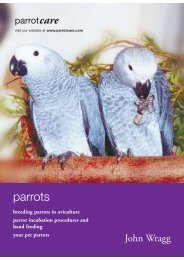incubation procedures and hand feeding - Parrotcare
incubation procedures and hand feeding - Parrotcare
incubation procedures and hand feeding - Parrotcare
You also want an ePaper? Increase the reach of your titles
YUMPU automatically turns print PDFs into web optimized ePapers that Google loves.
parrotcare visit our website at www.parrotcare.com<br />
Full wing feathers<br />
At this stage, 25 oC underfloor heating is adequate. At<br />
PARROTCARE all chicks are placed in a play pen at this<br />
stage <strong>and</strong> allowed access to food. Throughout all stages<br />
of h<strong>and</strong> <strong>feeding</strong> the formula is gradually thickened up<br />
whilst ensuring the food is clearing the crop. A mistake<br />
often made is to feed chicks too thin a formula over the<br />
early stages of its life <strong>and</strong> if this is taken to the extreme<br />
the chick may die of malnutrition. All baby parrots at<br />
PARROTCARE are weaned directly onto a complete diet.<br />
This ensures that adequate nutrition is available throughout<br />
the early stages of a chick’s life. At a later stage,<br />
additional fruit <strong>and</strong> vegetables diced can be placed in a<br />
separate bowl <strong>and</strong> added to the baby’s diet.<br />
Transfer to a cage<br />
Once the baby is perching adequately <strong>and</strong> sampling<br />
pellets, it is transferred to a cage to simulate its future<br />
environment. Perches are placed low with food bowls<br />
easily accessible at each end <strong>and</strong> directly in front of the<br />
bird at the same level as the perch. Pellets are easily<br />
accepted <strong>and</strong> produce little waste. If the temperature<br />
does drop in the weaning area, chick heat can be<br />
supplemented via an infra red lamp. Cages in which<br />
baby parrots are weaned should have wire floors to<br />
ensure that any faeces or leftover food drops in an area<br />
inaccessible to the chick.<br />
formulas<br />
In the early years at<br />
PARROTCARE we always<br />
mixed our own formula<br />
from the following recipe:-<br />
Haiths Necta blend<br />
25%<br />
Haiths PTX Budgie<br />
Rearing food<br />
25%<br />
Malupa fruit<br />
25%<br />
Malupa vegetable<br />
25%<br />
Added to the above a<br />
good quality mineral <strong>and</strong><br />
vitamin solution. At about<br />
4 weeks of age we<br />
added crushed whole<br />
sunflower seed. At PARROTCARE we found this diet to<br />
be more than adequate <strong>and</strong> I can not recall losing a<br />
chick because of nutritional deficiencies. For the past<br />
10 years we have used a prepared h<strong>and</strong> rearing formula<br />
as it is a lot more convenient than mixing your own <strong>and</strong><br />
also tremendous levels of scientific research have been<br />
entered into in the preparation of these products to<br />
ensure all the dietary needs of different types of parrots<br />
are catered for. It is possible now to purchase a formula<br />
which specifically caters for the needs of Macaws <strong>and</strong><br />
Eclectus <strong>and</strong> a second formula which is adequate for all<br />
other types of parrot.<br />
Care must be taken to mix formula as per<br />
manufacturer’s instructions. Too thin <strong>and</strong> it can cause a<br />
retarded chick <strong>and</strong> malnutrition, too thick <strong>and</strong> it may find<br />
difficulty passing through the crop. Describing the<br />
correct consistency<br />
for formula can be<br />
quite difficult but,<br />
suffice to say it should<br />
be thick enough to<br />
flow off the spoon<br />
when the chick is<br />
begging.<br />
We never reheat or<br />
reuse formula once<br />
the end of a feed<br />
arrives. All food leftover<br />
is discarded <strong>and</strong><br />
all <strong>feeding</strong> utensils<br />
sterilised.<br />
temperature of food<br />
This is an important issue <strong>and</strong> if the food is fed too cold<br />
the chick may choke on the contents of the spoon as it<br />
attempts to reject the formula. A method which we use<br />
at PARROTCARE is to check the temperature of the food<br />
with the lips. If the food feels the right temperature to<br />
you then it is the right temperature for the chick. In the<br />
early stages of a chick’s life the temperature of the food<br />
is more important than in later life. A chick will take<br />
coolish food from a warm spoon as it can feel the heat<br />
from the spoon. When <strong>feeding</strong> very young chicks it is<br />
important to dip the spoon into warm water to maintain<br />
its temperature throughout the <strong>feeding</strong> period. The<br />
smallest spoon possible is used over the first week or<br />
so. Spoons are modified by turning in each side to<br />
provide a funnel leading to a narrow point at the end.<br />
Spoons should be made from the finest material<br />
possible <strong>and</strong> at PARROTCARE we have always found<br />
the old fashioned tiny silver spoons to be perfect for the<br />
task. As the chick grows older, the spoon is increased in<br />
size to hold extra formula. Food that is too hot is far<br />
more dangerous than food that is too cold.<br />
Unfortunately, we have heard of chicks dying with<br />
burnt crops.<br />
the digestive system<br />
Lactobacillus is an important ingredient in commercially<br />
produced h<strong>and</strong> rearing formulas. Additional lactobacillus<br />
can be purchased separately <strong>and</strong> added to any formula<br />
when it will be most appreciated at the beginning of the<br />
chick’s life. Lactobacillus provides good bacteria which<br />
enables the food to be digested more readily. If negative<br />
bacteria enters the crop, then this can cause illness <strong>and</strong><br />
may have to be treated through antibiotics. It is essential<br />
to ensure that good bacteria enters the crop at the<br />
earliest possible stage, <strong>and</strong> therefore the first feed<br />
should contain a high level of lactobacillus.



